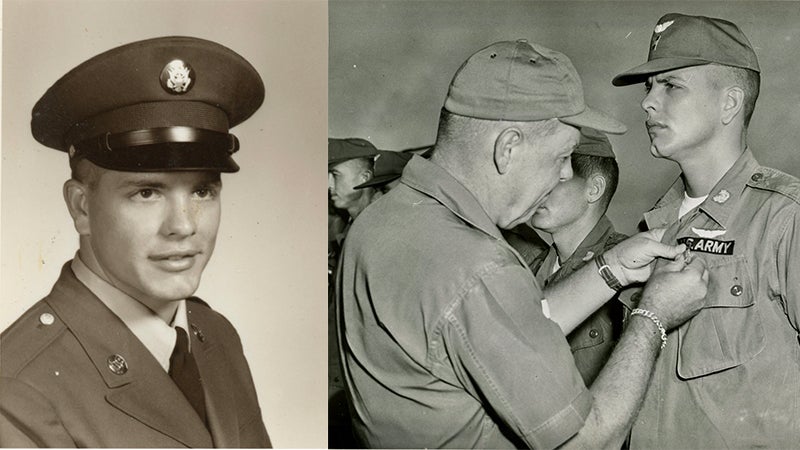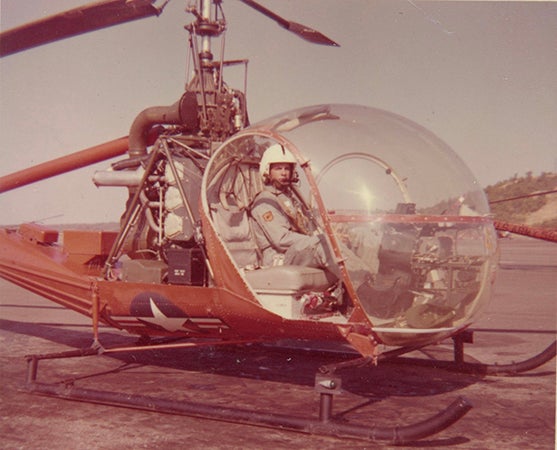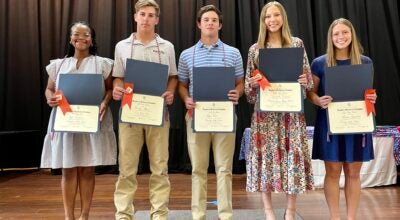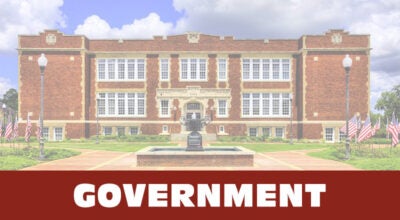Mark A. King, WO1, U.S. Army, Helicopter Pilot, Vietnam War Part 1
Published 1:00 pm Friday, January 27, 2023

- LEFT: Warrant Officer candidate Mark King, U.S. Army. [Photo: Mark King] RIGHT: Brig. Gen. Oden pins the Air Medal on WO1 Mark King, Tan Son Nhut, Airbase, Vietnam, Aug. 24, 1964. [Photo: Mark King]
|
Getting your Trinity Audio player ready...
|
Warrant Officer King did his best to hide behind the dyke at the edge of the rice paddy. He and Skip Bundy had just guided his UH-1B Huey to a “controlled crash” in the middle of a rice paddy near Vinh Long, South Vietnam, after his engine was taken out by enemy fire. With bullets flying overhead, he and his crew had crawled toward a dyke for protection. Fearing he was about to be overrun, he thought, “What am I going to do with a .357 sidearm and six bullets?”

Warrant Officer candidate Mark King in his OH-23 Hiller helicopter trainer at Fort Wolters, Texas. [Photo: Mark King]
Fortunately, King didn’t have to use the M-60. He recalled, “About 15 helicopter gunships suddenly appeared overhead and proceeded to rake the enemy positions with suppressing ground fire. An unarmed helicopter [called a ‘slick’] came in, picked us up and took us back to Saigon.”
For his actions near Vinh Long on June 19, 1964, Warrant Officer Mark A. King received the Army Commendation Medal of Valor.
Mark Anthony King was born December 12, 1942 in Andalusia, Alabama. His parents were Gaston and Oletta Donaldson King. Mark had two older brothers, Joel and Wayne and would have a younger brother, Harry. Mark graduated from Andalusia High School in 1961 where he was a star football player on the bulldog football team. After graduation, he signed a football scholarship to play for Auburn University. At the end of his freshman year, he was playing second team guard for the Tiger freshman team coached by Vince Dooley.
During the summer of 1962, Mark worked for the City of Andalusia as a meter reader. He decided to give up football and enlist in the Army. Mark was one of the first five civilians selected to go directly into helicopter training. Prior to that time, helicopter trainees came from the regular Army. He was sent to Fort Polk, Louisiana, and completed basic training in 1963. King was then sent to Warrant Officer Candidate School and basic helicopter training at Fort Wolters, Texas. Mark finished pre-flight training in late December 1963. From there, he was sent to Fort Rucker, Alabama, for advanced helicopter training where he flew the UH-1A Huey. King Received his wings and was commissioned as a Warrant Officer on May 12, 1964. He was sent to Vietnam on June 11, 1964.
King recalled his arrival at Tan Son Nhut Air Base in Saigon, “As I exited the plane, two First Lieutenants [Swift and Ikman], met me at the bottom of the stairs. They pulled me aside and asked if I wanted to fly gunships. I replied that I did and they proceeded to take me to the assignment office. There I met a Major I remembered from Fort Wolters who asked me if I had any problem ‘killing the enemy?’ I told the Major, ‘None whatsoever.’ That’s why I thought I was sent over here.’” King was assigned to the UTT [Utility Tactical Transport] Company, Dragon Platoon.
A few days later came the mission described above near Vinh Long. Although King was not wounded in the controlled crash near Vinh Long, He realized that the gunships had “saved the day.”
Warrant Officer King received his first purple heart not too long after the Vinh Long mission. He recalled, “We were flying a recon mission west of Saigon. My aircraft call sign was ‘Saber 7 alfa,’ and I was flying wing for my company commander, Major Jim Jagers [call sign ‘Saber 6]. We were flying a recon mission and doing a low-level run with fire. Just before I was hit, I saw bunkers built into the side of a rice paddy dyke. Suddenly, a large caliber bullet came through the windshield and hit my rocket sight, just two inches from my face. The rocket sight blew back into my face, knocking me off the controls and exited through my door window, leaving a large hole. My crew pulled me off the controls to see how badly I was injured. My co-pilot, Mike Davis, was able to recover the aircraft and fly us out. We called ‘Saber 6’ and suggested we find another landing zone.”
In a month or so, King was made aircraft commander and assistant armament officer. He was also named Class A Officer [or paymaster] for the UTT Company. The troops were limited in how much cash they could receive and King disbursed about $65,000 per month.
On one occasion when the armament officer was on leave, King was asked to demonstrate a new rocket launcher for Brig. Gen. Delk Oden. The 2.75 in. rockets were carried in two pods mounted underneath and on either side of the helicopter. Each pod carried 18 rockets and the test required firing all 36 at one time. After flying with the general to the test range, King landed and left the general at the observation area. He then lifted off and proceeded down range to line up with the target.
King recalled, “As I came across the firing line, I was aiming 500 yards downrange.
When I fired the rockets, the helicopter stood on its nose at about 900 feet. As I was recovering the ship, I could see rockets hitting from the 500 -yard line, all the way back to where Gen. Oden and my crew were standing behind a berm. The last two rockets landed within 50 yards of Gen. Oden. When I returned to the observation area, they motioned for me not to land but to hover. They removed the pods as I hovered. It turned out that the bomb brackets couldn’t hold the front of the pods and they were hanging down at about 90 degrees. After I sat the aircraft down, we found that one rocket had hit the skid on the pilot’s side and knocked out a chunk. Thereafter when Gen. Oden wanted a test done, he asked for me. I also had the privilege of flying his boss, Lt. Gen. Easterbrook.”
In late September or early October of 1964, King was part of an incursion into Cambodia that destroyed a village and caused an international incident. He recalled the incident, “We landed at a special forces camp and were briefed on the mission, complete down to which houses to hit first. A special forces Captain accompanied us as an observer. The mission went perfect as planned. We left the area and proceeded to shoot up sampans on a nearby canal. We were traveling at low speed, at a low altitude when we were ambushed. I saw a VC [Viet Cong] come out of the water with a shotgun, firing straight at me. I heard the impact on the aircraft but was not harmed. After landing the aircraft back in Vietnam, we counted 26 bullet holes in the aircraft. One shot hit on the side of the aircraft where I was sitting but was stopped by the side-armor plate on my seat. One shot hit the observer Captain in the leg. He had to be evacuated back to the States for surgery. He was not unhappy with his ‘million-dollar ticket’ back home and we had several toasts at our bar before he left.”
The battle of Benh Gia was fought in late December. The Dragon Platoon was sent in to assist an ARVN [South Vietnamese Army] unit which had been ambushed and decimated by the VC. By the time King and the other pilots arrived, the VC had withdrawn. The Dragon Platoon put down suppression fire in the surrounding area while the dead and wounded were removed.
End Part 1.
John Vick



